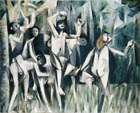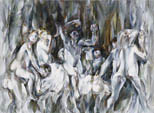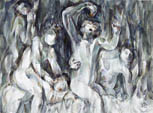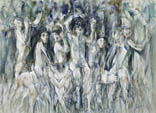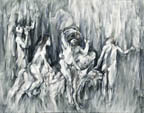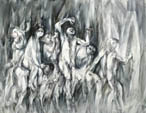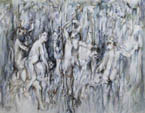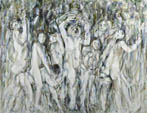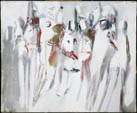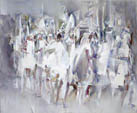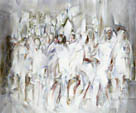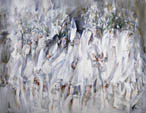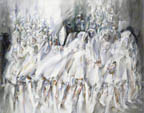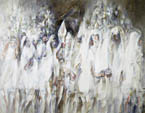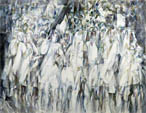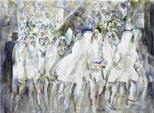In1954 leBrocquy painted Children in a wood,
inspiredby a painting by the 17th-century Dutch artist Nicolaes Maes.
In 1962 he painted another painting of children, Procession with Lilies,
prompted by a photograph which had been sent to him years earlier in 1939.
These two images of processions inspired a further series of work in the
1980s and
1990s. They demonstrate le Brocquy's continuing interest in the 'group'
of figures rather than the isolated individual so prevalent in other works
of the 1960s onwards. Dorothy Walker notes: 'The image of these jeunes
filles en fleur (et aux fleurs) has been simmering in the artist's
mind since 1939 when a friend in Dublin sent him, to France where he was
then living, a newspaper cutting from the Evening Herald showing
a group of young girls in white First Communion dresses, coming around
a corner, laughing and carrying white lilies. The caption to the photograph
was "Schoolgirls returning from Church after the blessing of the Lilies
on the Feast
of St Anthony." The date on the newspaper was 16 June 1939, the date
of the publicationof Finnegan's Wake ... He was also struck by
the complementary paradoxes in the image, the togetherness and the scattered
individuality: all the faces facing forward, all caught up notmerely in
a communal event but also in a common physical movement, the movement of
a flock, in their rush around the corner of the street. Later on,he was
also struck by the haphazard conjunction of dates, that this epiphanic
Dublin photograph should have been published on the same day as Finnegan's
Wake. The image of happy, excited children was sharpened by the poignancy
of the date, Bloomsday 1939, so soon before the doomsday of war, almost
the last Bloomsday of Joyce's life ... Le Brocquy has spent so much of
his working life inside Joyce's head, as it were, that this simple, accidental
newspaper cutting thus assumed further significance for him. It seemed
to him to be an illumination of Joyce's own words, a "fluid succession
of presents", a chain of present moments, a river of life.'
Peter Murray. Eros and Thanatos. Louis le Brocquy’s ‘Procession’ paintings
